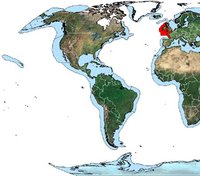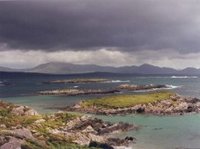Celtic-Biscay Shelf large marine ecosystem
 Location of the Biscay Shelf Large Marine Ecosystem. (Source: NOAA)
Location of the Biscay Shelf Large Marine Ecosystem. (Source: NOAA) The Celtic-Biscay Shelf Large Marine Ecosystem (LME) is situated in the Northeast Atlantic Ocean and has a temperate climate. The marine bodies covered by this marine ecosystem enclude the Celtic Sea and the Bay of Biscay. At its southern limit the shelf is steep and narrow, but it widens steadily along the West coast of France, merging with the broad continental shelf surrounding Ireland and Great Britain. Four countries, Ireland, Great Britain, France and Spain, border the LME. The Celtic-Biscay Shelf is characterized by a strong interdependence of human impact and biological and climate cycles (see Koutsikopoulos and Le Cann, 1996). A chief source addressing this LME is Valdes and Lavin, 2002, on the Bay of Biscay.
Contents
- 1 Productivity
- 2 Fish and Fisheries
- 3 Pollution and Ecosystem Health
- 4 Socioeconomics
- 5 Governance
- 6 Articles and LME Volumes FAO, 2003. Trends in oceanic captures and clustering of large marine ecosystems—2 studies based on the FAO capture database. FAO fisheries technical paper (Celtic-Biscay Shelf large marine ecosystem) 435. 71 pages. * Prescott, J.R.V. 1989. The political division of large marine ecosystems in the Atlantic Ocean and some associated seas. In K. Sherman and L.M. Alexander, eds. Biomass Yields and Geography of Large Marine Ecosystems. AAAS Selected Symposium 111. Westview Press, Boulder CO. 395-442. ISBN: 0813378443. * Valdes, L. and A. Lavin, 2002. Dynamics and human impact in the Bay of Biscay: an ecological perspective. In K. Sherman and H.R. Skjoldal, eds. Large Marine Ecosystems of the North Atlantic—Changing states and Sustainability. Forthcoming volume, Elseviers. 293-320.
- 7 Other References
Productivity
This LME’s dynamic is governed by climate and tides. For a map of the Bay of Biscay, see Valdes and Lavin, 2002, p. 294. The LME is influenced by the North Atlantic Drift in the North, and by the Azores Current in the South. For information on circulation and currents, see Koutsikopoulos and Le Cann, 1996. The region undergoes a seasonal climatic cycle that strongly affects the pelagic ecosystem through forcing factors: sunlight exposure, heat input, and mechanical forcing on the surface due to wind. For more information on seasonal variability, the vertical structure of coastal and oceanic waters, river plumes, coastal runoff and tidal fronts, see Valdes and Lavin, 2002. For a map of temperature distribution in the Bay of Biscay, in Valdes and lavin, 2002, p. 297.
The Celtic-Biscay Shelf LME is considered a Class I, highly productive (>300 grams of Carbon per meter squared per year) ecosystem based on SeaWiFS global primary productivity estimates. Living marine resources include a wide range of organisms. In terms of biogeography, the LME is a region of transition and there is a richness in floral and faunal species. It is difficult to determine the states of equilibrium of species and communities. Natural variability occurs on a wide range of space and time scales (seasonal, inter-annual, decadal and centennial cycles). This LME is positioned in the eastern section of the North Atlantic, and therefore is in the area of the cyclical oscillations of the North Atlantic Oscillation (NAO). For more information on [[coast]al] upwelling, and on the warm and salty current called Navidad, see Valdes and Lavin, 2002.
Fish and Fisheries
 LME: Biscay Shelf (Source: NOAA)
LME: Biscay Shelf (Source: NOAA) The natural variability of this LME adds a high degree of uncertainty to the management of marine resources. The marine resources exploited in the LME include molluscs, whales, seaweeds, herring, redfish, sand eels, and mackerel. The Food and Agriculture Organization (FAO) 10-year trend shows a decrease from 1,150,000 tons in 1990 to 900,000 tons in 1999 (see FAO, 2003). The most important species group in terms of shelf catches are pelagic fishes, representing about 46% of the catch on average. The second most important species group is clupeoids (about 15%). Cods, hakes and haddocks average about 14%. There were peak catches of capelin in 1992-1993. For more on sardine recruitment, see Valdes and Lavin, 2002.
Cyclical oscillations, such as the NAO, have been related to fluctuations in abundance of albacore and bluefin tuna (see Ortiz de Zarate et al, 1997; and Santiago, 1997). Many fish stocks are either intensively exploited or depleted. There are TAC regulations for anchovy, hake, and blue whiting. General information on fisheries, environmental conditions, human activities, and pollution (Water pollution) for the Celtic-Biscay Shelf Large Marine Ecosystem can be found in the OSPAR Quality Status Report. The University of British Columbia Fisheries Center has detailed fish catch statistics for this LME.
Pollution and Ecosystem Health
 (Galen R. Frysinger. Source: NOAA)
(Galen R. Frysinger. Source: NOAA) There are ecological disturbances of target fish species, with alterations in the abundance, distribution and diversity of fish and marine mammals. Water pollution and global change are impacting different types of [[coast]al] habitats (estuaries, coastal lagoons, rocky cliffs, rocky shores, sandy and muddy shores). For more on the effects of ecosystem variability and human impact on species and habitats of the Bay of Biscay, see Valdes and Lavin, 2002. The ecosystem is affected by alterations to the seabed, the introduction of non-indigenous species, agriculture and sewage (see Valdes and Lavin, 2002). Introduced species are naturally transported by currents or are human-induced, caused by an intensification of fisheries and by travel in ballast water on commercial vessels.
The use of DDT in agriculture within the basin has now been banned; however, runoff from other herbicides and pesticides continues to contaminate these LME waters. There is pressure on the coastal margins from industrial activities known to cause pollution, such as paper mills, petroleum refineries, iron and steel works and chemical plants. For more information on industrial discharges, inorganic and organic compounds, mercury (associated with paper mill industries), and PAHs (linked to human activities such as marine oil extraction, industry and oil traffic), see Valdes and Lavin, 2002. Estuaries and coastal lagoons receive most of the impact of microbiological contamination of urban origin. In 1992, an oil spill was caused by the supertanker Aegean Sea. The toxic effects of the oil caused a temporal reduction of the macroinfauna (amphipods, echinoderms, molluscs), with a simultaneous dramatic increase of opportunist polychaetes. In December 1999, the supertanker Erika spilled 10,000 tons of oil in shallow waters off the coast of France. Due to the strong wind in the area, the “black tide” moved to the coast and large expanses of French beaches were contaminated by oil. General information on environmental conditions, human activities, and pollution for the Celtic-Biscay Shelf Large Marine Ecosystem can be found in the OSPAR Quality Status Report.
Socioeconomics
 (Source: NOAA)
(Source: NOAA) Traditionally the LME has been a region of intense fishing activity. Whale hunting as an activity began along the Spanish coast in the Middle Ages. Approximately 5000 French and Spanish fishing boats are currently active in the Bay of Biscay. Human activities in the coastal areas also include aquaculture and farming. Population densities at the coastal edges of the Celtic-Biscay Shelf Large Marine Ecosystem are increasing. This fast population growth and socioeconomic development have resulted in environmental imbalances. Extra pressure was added through tourism, the new urbanization of coastal areas, transportation and recreational uses of beaches and shores. General information on human activities and pollution (Water pollution) for the Celtic-Biscay Shelf Large Marine Ecosystem can be found in the OSPAR Quality Status Report.
Governance
Presently there is limited capacity to plan a sustainable development policy for the [[coast]al areas] (see Valdes and Lavin, 2002). The countries situated at the edge of this Large Marine Ecosystem (Ireland, Great Britain, France and Spain) are all members of the European Union. The use of natural marine resources in this LME follow a number of conventions, declarations and regulations, including the European Commission directives and regulations within the Common Fisheries Policies. All in all a large number of instruments from international bodies, such as the United Nations, the International Maritime Organization, and the European Union, exist to conserve natural resources, protect the environment and ensure health and safety standards. The European Community laws protect the environment in terms of air (Air pollution) and noise, chemicals and industrial risks, nature conservation, waste and water.
Articles and LME Volumes FAO, 2003. Trends in oceanic captures and clustering of large marine ecosystems—2 studies based on the FAO capture database. FAO fisheries technical paper (Celtic-Biscay Shelf large marine ecosystem) 435. 71 pages. * Prescott, J.R.V. 1989. The political division of large marine ecosystems in the Atlantic Ocean and some associated seas. In K. Sherman and L.M. Alexander, eds. Biomass Yields and Geography of Large Marine Ecosystems. AAAS Selected Symposium 111. Westview Press, Boulder CO. 395-442. ISBN: 0813378443. * Valdes, L. and A. Lavin, 2002. Dynamics and human impact in the Bay of Biscay: an ecological perspective. In K. Sherman and H.R. Skjoldal, eds. Large Marine Ecosystems of the North Atlantic—Changing states and Sustainability. Forthcoming volume, Elseviers. 293-320.
Other References
- Atlas of the living resources of the sea. 1972. Department of Fisheries, Food and Agriculture Organization of the United Nations (FAO), Rome. ISBN: 9250010001.
- Koutsikopoulos, C. and B. Le Cann, 1996. Physical processes and hydrological structures related to the Bay of Bsicay anchovy. Scientia Marina, 60(2):9-19.
- NOAA. 1991. Report of the ad hoc Committee on Large Marine Ecosystems. NOAA Technical Memorandum NMFS-F/NEC-92, 19p.
- Ortiz de Zarate, V., A. Lavin and X. Moreno-Ventas, 1997. Is there a relationship between environmental variables and the surface catch of albacore Thunnus alalunga (Bonnaterre, 1788) in the North Atlantic? SCRS/97/54.
- Report of the Advisory Committee for Fisheries Management. In ICES Annual Report, 81st Statutory Meeting. 1993. International Council for the Exploration of the Sea. Dublin, Ireland.
- Santiago, J. 1997. The North Atlantic Oscillation and recruitment of temperate tunas. SCRS/97/40.
| Disclaimer: This article contains information that was originally published by the National Oceanic and Atmospheric Administration (NOAA). Topic editors and authors for the Encyclopedia of Earth have edited its content and added new information. The use of information from the National Oceanic and Atmospheric Administration (NOAA) should not be construed as support for or endorsement by that organization for any new information added by EoE personnel, or for any editing of the original content. |
